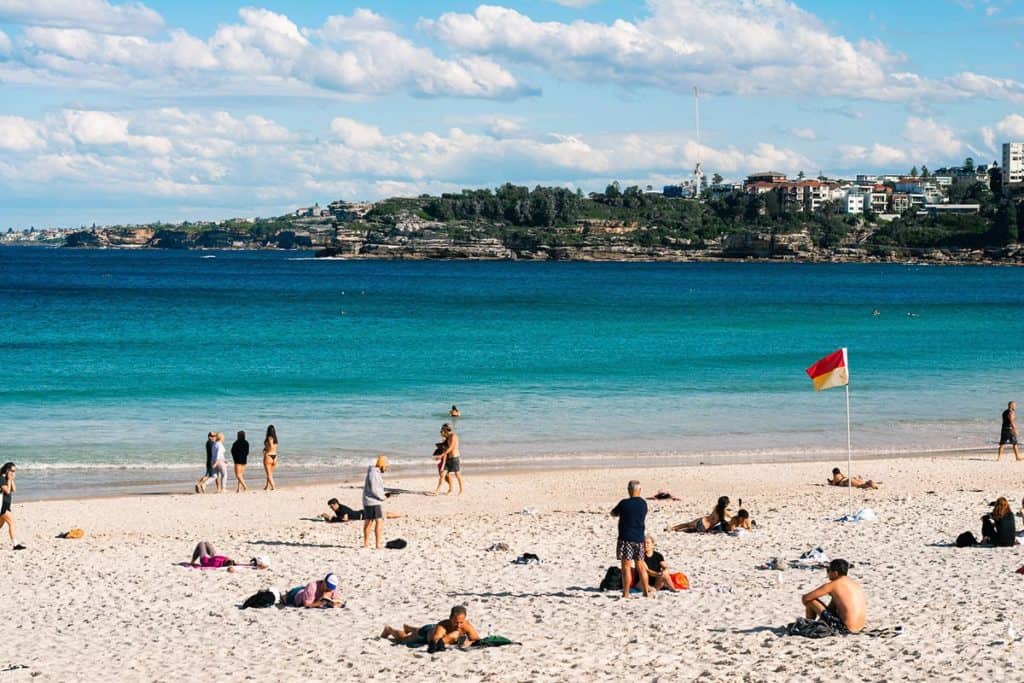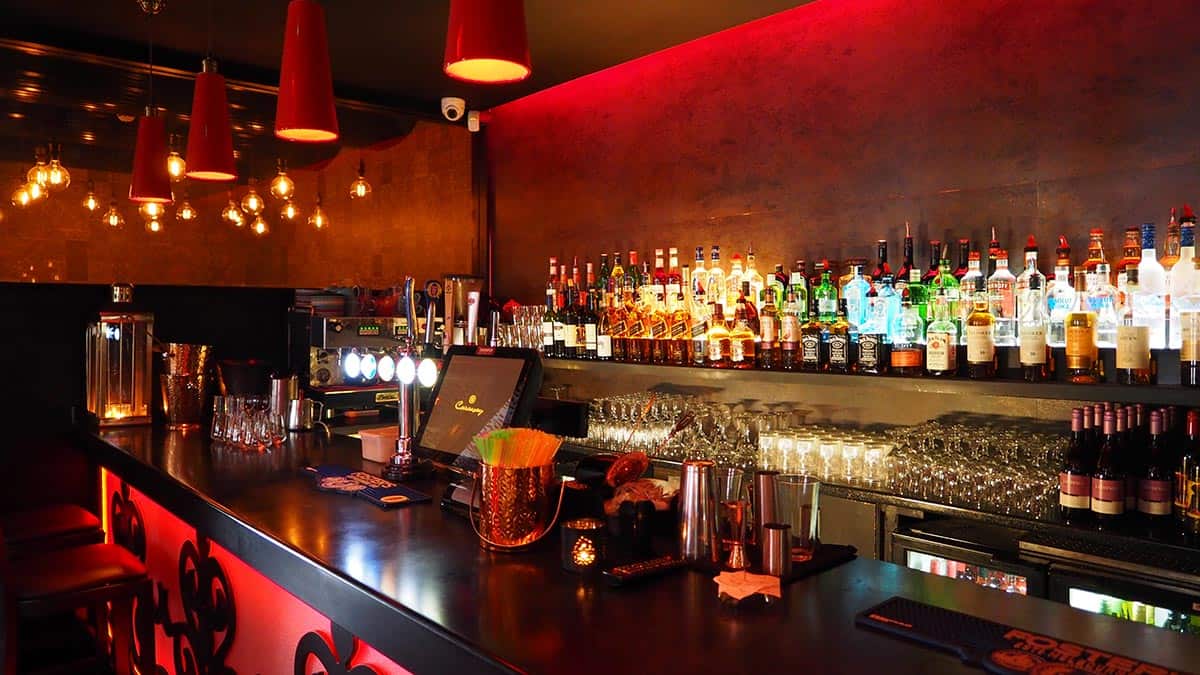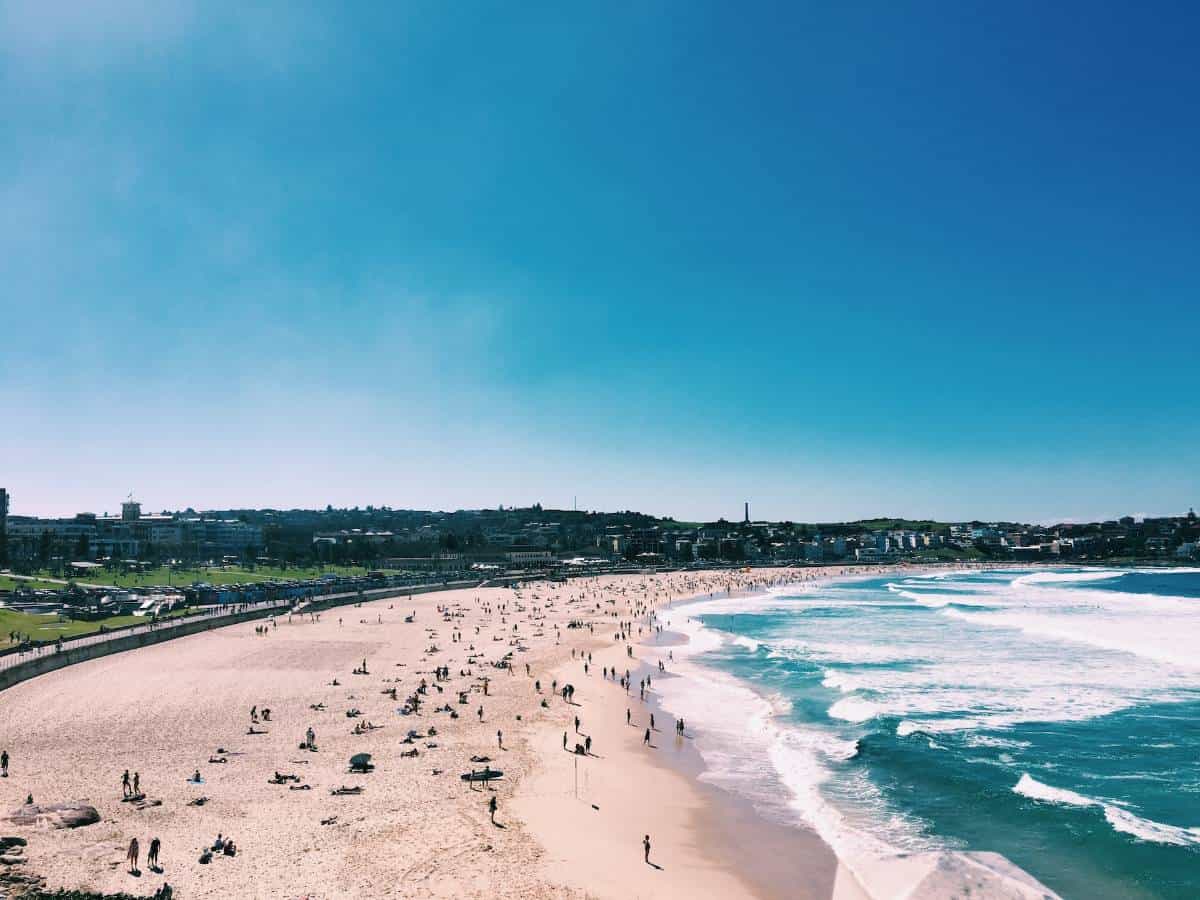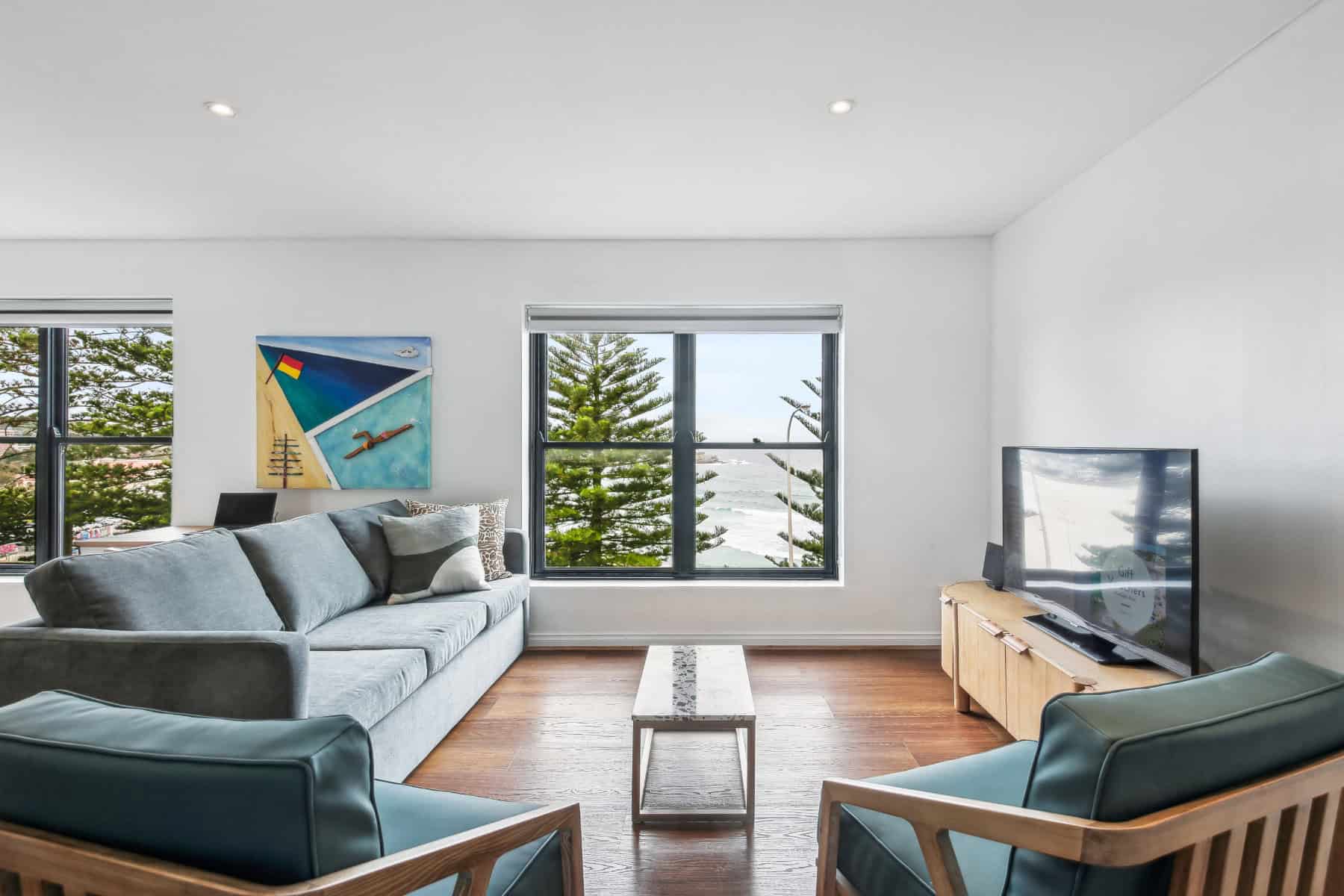Wondering how old Bondi Beach is? It is estimated to be around 2,000 years old and deeply rooted in Aboriginal history. In this article, we will uncover its fascinating journey from ancient times to modern-day popularity.
Key Takeaways
- Bondi Beach has a deep Aboriginal heritage. Its name reflects the area’s indigenous roots, and ancient rock carvings highlight its cultural significance.
- Francis O’Brien’s transformation of his estate into a public pleasure resort in the mid-19th century was pivotal in making Bondi Beach accessible to the public, although government intervention was necessary to open the beach formally in 1882.
- The Bondi Pavilion, a major infrastructural development in the 1920s, has undergone significant changes over the years and was recognised as a heritage site in the late 20th century, reflecting its importance in Sydney’s cultural and social history.
The Origins of Bondi Beach
Before it became a popular spot for sunbathing and surfing, Bondi Beach was the traditional land of the Gadigal, Bidiagal, and Birrabirragal clans. These indigenous groups lived harmoniously in the area, along with approximately 1,500 Aboriginal people who resided between Broken Bay and Botany Bay, including the Watsons Bay area.
The Waverley Council area, where Bondi Beach is located, contains 11 registered archaeological sites that provide a glimpse into the lives of the original inhabitants. The Australian Museum records further contribute to our understanding of this significant history.
The name ‘Bondi’ itself is a tribute to the Aboriginal heritage of the area, coming from an Aboriginal word meaning ‘water breaking over rocks‘. This name vividly describes the natural beauty that early settlers would have seen along the coastline, including the iconic Bondi Icebergs. The ancient rock carvings, estimated to be around 2,000 years old, testify to the area’s cultural significance and hint at the indigenous people’s deep spiritual connection with the land and the sea.

The Bondi Estate and Francis O’Brien
In the mid-19th century, the Bondi Estate became a significant landmark after being purchased for £300 by Edward Smith Hall. He then passed it to his daughter, Georgiana, and her husband, Francis O’Brien. Unable to sell the land after attempting to subdivide it, O’Brien made a crucial decision.
He transformed the area into the ‘O’Brien Estate’ from 1855 to 1877, turning it into a popular picnic ground and pleasure resort. This act provided public access to the beach and contributed to the transformation of Bondi into one of Sydney’s most beloved eastern suburbs. The O’Brien family’s house, known as ‘The Homestead,’ featured extensive gardens, and the estate included several freshwater lagoons, one of which covered two acres. Tragically, Francis O’Brien’s daughters drowned in one of the lagoons on the property. Despite this, the family continued to be active in the community, and the estate played a central role in Bondi’s development.
Public Access and Government Intervention
However, the tale of Bondi Beach is not without its conflicts. The Municipal Council, recognising the beach’s importance to the community, petitioned the government as early as 1859 to declare it a public reserve. However, it was initially to no avail. It was only when Francis O’Brien himself threatened to stop public access that the government stepped in.
In the act of preservation and public interest, Bondi Beach was officially opened to the public in June 1882, ensuring that it would remain a place for all to enjoy.
The Arrival of Trams and Increased Popularity
The arrival of trams in 1894 was a game-changer for Bondi Beach, connecting it to the city and making the journey from Sydney’s CBD to the sandy shores possible and convenient. This accessibility marked the beginning of Bondi Beach as a major recreational destination, with the area around it developing into a bustling hub of activity. The trams increased the popularity of the beach, drawing many visitors and sparking a love affair with the sea that continues to this day.
Early 20th Century Developments
In the early 20th century, Bondi Beach began to shape its identity as a haven for sea lovers. In a significant move towards leisure and freedom, daylight bathing was finally permitted in 1902. This newfound liberty coincided with the birth of the surf lifesaving movement, and in 1907, the Bondi Surf Bathers’ Life Saving Club was founded, cementing Australia’s place in the history of surf lifesaving as home to dedicated local lifesavers, also known as surf lifesavers.
The establishment of this club not only provided safety for the increasing number of bathers but also fostered a culture that would become synonymous with Bondi Beach.
Construction of the Bondi Pavilion
As the popularity of Bondi Beach soared, so did the need for infrastructure that catered to the growing number of visitors. Enter the Bondi Pavilion, a grandiose structure resulting from a design competition won by the architectural firm Robertson & Marks in 1923. This ambitious project included:
- a pavilion
- Turkish baths
- shops
- a ballroom
All of these officially opened in 1929.
The Pavilion’s Turkish and Hot Sea Water Baths in Bellevue Hill became a relaxing sanctuary with a massage room and lounge.

Mid-20th Century Changes
The Bondi Pavilion and Bondi Beach itself were not immune to the tides of change, especially during the tumultuous years of World War II. The Pavilion found a new role as an officer’s club for the American Red Cross, serving those who fought far from home.
Post-war, the Pavilion’s offerings expanded, including:
- The addition of a liquor license in 1948 allowed for a variety of social events
- Repurposing of the Turkish Baths into a gymnasium
- Establishment of the Bondi Theatre Group, marking the start of a cultural renaissance at the Pavilion.
Heritage Recognition and Modern Upgrades
The historical value of Bondi Pavilion was formally recognised as the 20th century drew to a close. It was included as a heritage site in the 1990s and listed on the State Heritage Register in 2008, highlighting its significance in Sydney’s cultural and social landscape. The Pavilion underwent modernisation while preserving its historical integrity, leading to several upgrades. In 2022, the Pavilion reopened with improved facilities, including the Bondi Story Room, a space dedicated to the beach’s heritage.
Dive into Bondi Beach: Some Unforgettable Experiences that Await
Bondi Beach isn’t just a world-famous stretch of sand; it’s a vibrant hub pulsating with excitement. Whether you crave adventure on the waves or a taste of the local scene, Bondi Beach has something for everyone. Here’s a glimpse into what awaits:

- Catch a Sunrise at Ben Buckler Point: Witness the magic of a new day as the golden light paints the sky. The panoramic views from Ben Buckler Point are truly breathtaking.
- Tame the Waves: Unleash your inner surfer with a lesson at Bondi Beach, a haven for beginners and seasoned surfers alike. Feel the thrill of riding a wave and the refreshing ocean spray.
- Explore the Bondi to Coogee Walk: Lace up your walking shoes and embark on this scenic coastal route. Discover hidden coves, charming cafes, and stunning rock pools along the way.
- Unwind at Bondi Icebergs: Take a dip in the iconic Bondi Icebergs saltwater pool, a local landmark with incredible ocean views. Perfect for a refreshing swim or simply soaking up the atmosphere.
- Dive into Bondi’s Culture: Stroll along the beachfront promenade to explore the vibrant art scene. Discover local galleries like Aquabumps, which showcase the essence of Bondi life.
Bondi38 Serviced Apartments: Your Bondi Beach Oasis
Bondi38 Serviced Apartments offers a perfect retreat at Bondi Beach. The apartments are ideally located near the beach, providing a comfortable and luxurious home base for your Bondi adventure. Wake up to the sound of crashing waves and enjoy the stunning view of Bondi Beach from your private balcony.
Our fully self-contained apartments offer keyless entry, air-conditioned comfort, complimentary Wi-Fi, well-equipped kitchens, and Foxtel access for entertainment. From studios to two-bedroom apartments, each unit is meticulously designed for your comfort.
Book your stay at Bondi38 Serviced Apartments today and indulge in the magic of Bondi Beach.
Frequently Asked Questions
What is the origin of the name ‘Bondi’?
The name ‘Bondi’ is derived from an Aboriginal word meaning ‘water breaking over rocks,’ reflecting the natural beauty of the area where the water meets the land. This reflects the region’s Indigenous history and natural landscape.
When was Bondi Beach officially opened to the public?
Bondi Beach was officially opened to the public in June 1882 after the government intervened due to Francis O’Brien’s threats to restrict access.
What is the significance of Bondi Pavilion?
Bondi Pavilion is significant as it has been the heart of Bondi Beach’s social and cultural life since 1929. It hosts various events and serves as a symbol of the beach’s heritage.
How has Bondi Pavilion changed in recent years?
Bondi Pavilion has recently undergone renovations to update its facilities and preserve its historical significance. It was reopened in 2022 with improved amenities, such as the Bondi Story Room.
Final Thoughts
Bondi Beach has witnessed an incredible evolution from the ancient Aboriginal clans to the sunbathers of today. Its journey from a secluded natural paradise to one of the world’s most famous beaches is a rich narrative of cultural significance, social change, and architectural innovation. As the waves continue to break over its iconic rocks, Bondi Beach remains a testament to the enduring spirit of community and the timeless allure of the sea.
After a day of adventure, unwind in style at Bondi38 Serviced Apartments. Located near the beach and buzzing with Bondi’s energy, Bondi38 offers the perfect home base for your Bondi adventure.
Book your stay at Bondi38 Serviced Apartments and experience the magic of Bondi Beach!















